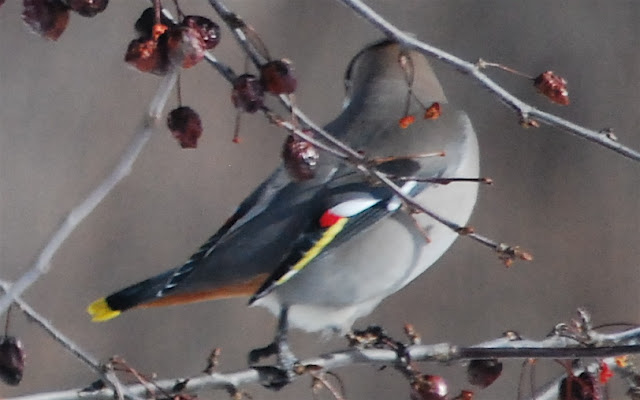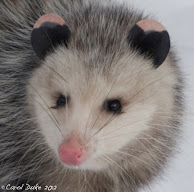 |
| Male Pine Grosbeak |
Long long ago . . . so it seems now . . . I had bird feeders all around the house. There was a suet feeder hanging on the south side, just outside the downstairs kitchen window, a couple of cylinder seed filled feeders dangled in front of the eastern living room windows and a small tray feeder was attached about seven feet off the ground to a bedroom storm window on the north side of the house. I enjoyed seeing the birds up close for many years in this way. Then the bear came! First, he found the suet feeder to his liking. Then off with the cylinder feeders tops and down the hatch . . . then that left one . . . a little tray feeder rested on suction cups right on the storm window, which was a foot away from where I lay sleeping. The bed was right up against the wall under the window. It was early morning early March just before sunrise. I was sleeping late that morning . . . a strange noise awoke me and I had barely opened my eyes, when I should see much to my immediate fright . . . a large black bear looming over me with only a thin plate of glass between us! I had opened up the inside window a few days before to better see the sky. He knocked the feeder down and then went tumbling in large mass, as only a bear can do . . . towards the compost pile. I jumped up . . . very glad the storm window could hold all that weight . . . ran into the kitchen and grabbed two large pots. Stepping outside I began banging the pots together making a loud noise . . . hoping this would scare the bear. He did run away but came back the very next day. Bears have very good memories . . . he came back for food he assumed . . . wrongly. . . would still be available to him. I had taken all the feeders down and to this day they have not gone back up. I could hear the familiar sound of his body rubbing up against the north corner of the house, as he came round to the bedroom window the next morning. I had pots nearby and began with my noise making defense right away. Bears are creatures of habits . . . and so . . . he ran away again right to the compost pile and after digging around a bit went on out of sight. I will share more bear stories on a later wildlife post.
I hope this explains why you never see bird feeders here at Flower Hill Farm.
My garden is my only bird feeder these days.
The Crabapple Orchard offers the most sought after food, while giving me great entertainment along with many opportunities for capturing birds in action.
It was a real joy to have Pine Grosbeaks visiting two years ago! I had never seen them before nor since, as they rarely come this far south. Pine Grosbeaks usually live in boreal forests in more northern mountainous areas across Asia, Europe and North America. The Crabapple Orchard was magical that winter as hundreds of birds were content to remain around for weeks enjoying the miniature apples. The small trees were filled and animated for hours each day with the colors, sounds and movements of this large flock of over a hundred birds. There was hardly any room in the orchard for my regular bird guests.
 |
| Female Pine Grosbeak |
They were not the least bit shy allowing me to open the windows, in order to take these photographs.
 |
| Immature male Pine Grosbeak |
This male Pine Grosbeak seems to have lost his tail! I would love to know his story. He was jumping around in the most unusual ways. At first I did not understand . . . then this photograph told me what was missing. He must have a hard time balancing and I am not sure how he can manage to fly without tail feathers.
Our American Goldfinches are a curious lot. They are strict vegetarians . . . eating mostly seeds, preferring asters, thistle, grasses and sunflowers. Here in the gardens they also love seeds of the White and Gray Birch. It is only in recent years that I have noticed them beginning to eat fruit in the gardens. I would see them flying around with Bluebirds and Robins and it seemed to me they were studying how these birds were eating fruit. Now I regularly see the Goldfinches eating Crabapples too. In early spring I noticed to my horror that they have taken to eating my Viburnum buds as well. The buds appear like tiny fruits before they open and just the right size for the Goldfinches to devour. Much easier than the larger and tougher Crabapples. I had to put my foot down at once on this new development!
The first year I had not realized what they were doing until I began to notice the buds looked deflated. They were not just deflated they were gone! Those little twits ate hundreds that year. I had not one flower nor did other birds get to enjoy the later developing fruits. So the chase began. I had to be on guard early morning until dusk every day. I was able to cover a few shrubs but most were too tall. I was amazed to see how quickly they learned to stop eating the buds, for the next year I only had to cover two shrubs and then they just stopped all together. I guess they did not enjoy being chased out of the gardens with long bamboo branches. It was funny to witness their behavior ( I am sure my behavior was not amusing to them, though I did feel a bit silly! ) and how they were able to learn from other birds to eat fruit, then suddenly began eating buds . . . well my red Viburnum buds did look very similar to tiny fruits. . . then simply stop eating what made me unhappy. Needless to say the garden was not harmonious with me running around with a large bamboo shaker! Shaking was all I could ever do, of course, for they were always higher than I could reach and I would never want to harm the pretty yellow birds anyway. My shrubs have rights too and the flowers offer important food for honeybees and other insects.
When Cowbirds lay an egg in the Goldfinches nests, the nestling will not survive on the vegetarian diet and it will usually die a few days after hatching. So Cowbirds are not a threat to the American Goldfinch. It is curious too that they wait until June to nest . . . for they prefer to build their nests from thistle and milkweed seeds and down. They raise their young on the seeds as well. Every May I must keep a careful eye out for their mischief . . . to be sure they are not up to their new old tricks of eating my precious Viburnum buds. How odd that they would suddenly begin to act this way . . . ever evolving I guess. We should all learn to expect the unexpected in nature.
After bites of apple a nice drop of water will just hit the spot.
The true masters of dining on crabapple fruit has to be the Waxwings. Cedar and Bohemian Waxwings look similar but the Cedar do not have the orange under the tail and are more brownish where Bohemian Waxwings are more blue-gray as these. These exquisite Bohemian Waxwings have learned how to position and toss the fruit up, then catch the apples midair swallowing them whole. Quite entertaining to watch. Bohemian and Cedar Waxwings can live for months on fruit alone. The Cowbird nestling has trouble surviving in their nests too because they need other protein to survive. These are some of my favorite bird photos. They remind me of pastels more than photographs. I think that is what I love about them. They were taken from inside . . . looking through glass . . . as Bohemian Waxwings are very shy and would immediately fly away, if I opened a window or door.
They flock to the Crabapple Orchard and like the Pine Grosbeaks above fill the trees with color much like beautiful exotic flowers. Bohemian Waxwings can get a bit tipsy from eating too many fermented apples.
Gulp! Gulp!
Fly carefully!
Planting a Crabapple Orchard or a few trees is a very good way to feed the winter birds. In the spring, birds feed on the many insects that seem to be attracted to the flowers. The trees are fantastic living bird feeders. Black Bears do not care for them!


















































































































































